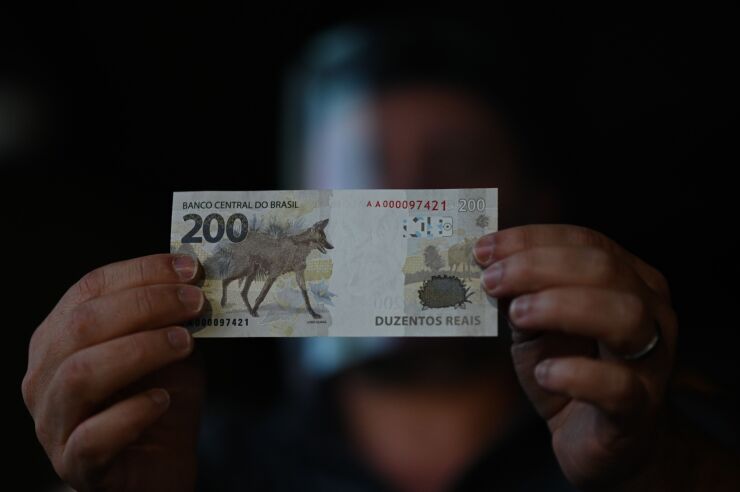Brazil aims to move beyond the era of cash payments on Monday, when the Banco Central do Brasil launches the
But even this attempt at modernization relies on a familiar technology, as QR codes will play a key role in moving the country away from its heavy reliance on cash.
The faster payments system, known throughout Brazil as PIX, has been in the planning stages for more than a year and in limited use since last week. The full launch brings the promise of delivering payments and transferring money in seconds through a 24/7 operation year-round, enabling PIX users to pay bills and make other payments through mobile devices or computers.
Brazilian businesses and consumers have been registering email addresses, mobile phone numbers or their personal ID numbers in preparation of using the system, and the Brazilian government is mandating that financial institutions licensed through the central bank with more than 500,000 accounts adopt the system.

Consumers will be able to choose PIX for e-commerce payment and as a P2P payment method, while businesses can use it to make payments to employees or freelancers. Additionally, merchants can deploy a QR code for its use at payment terminals or other displays.
The QR code, so popular for payments in some parts of the world, is vital to the PIX mission of achieving interoperability, which is a key for the system compared to others across the world, said Talie Baker, senior analyst with Aite Group.
"Interoperability is the key differentiator with PIX compared to what the Clearing House RTP and (bank-supported) Zelle offer in the U.S.," Baker said. "It is achieved through the use of QR codes so that any payment scheme or digital wallet that uses QR codes can facilitate money movement with PIX."
Such an arrangement will spur competition in the Brazil payments space, unlike RTP and Zelle, which facilitate money movement between banks and bank accounts, Baker added.
Brazil's central bank is looking to shake up the country's banking landscape, particularly with the potential of the country's estimated 45 million adults without bank accounts possibly being lured into using PIX and dropping reliance on cash.
The change will put Brazil in a playing field with other faster payments schemes globally, in addition to RTP in the U.S., such as
It is rare for a central bank to launch a payment scheme that promotes direct fintech competition with Brazilian financial institutions, Baker said.
"Because banks are not at the center of the payments scheme, PIX also encourages financial inclusion because it can facilitate payments to digital wallets without the need for an actual bank account," Baker added. "PIX also brings the cost of payments down by disintermediating third parties such as card networks."
The PIX system is not trying to fundamentally change how users interact with the financial system, so it will likely complement other digital advancements in the country, said Rodrigo Sanchez Prandi, vice president of product for emerging markets payment gateway dLocal.
Other payment methods in Brazil include a bank transfer system referred to as DOC and electronic funds transfers known as TED, options that require senders and recipients of transfers to know sensitive information like routing numbers, bank codes and bank account numbers. They also generally carry expensive transfer fees.
"Basically, PIX allows the use of whatever you have, a bank account or a new wallet, to operate through an integrated system," Prandi said. "You can wait for days for other payment methods in Brazil to work, and they don't operate on weekends."
Such a dramatic change opens the door for many use cases, Prandi added. "You can pay bills in restaurants through QR codes on display, and input the amount and tip for the waiter right on your mobile phone."
PIX also wants to operate alongside legacy systems for now, and is not looking to replace them, Prandi said. It is one of the major challenges regarding PIX, as financial institutions will have to connect to the scheme and assure proper security is in place.
The COVID-19 pandemic has also spurred an increase in citizens applying for government benefits online in Brazil, as the country's Digital Government Secretariat reported access to its online portal rose from 4.1 million users in February to 6.7 million in March, and 9.4 million in April.
PIX is designed to attract the unbanked citizens into using digital services for the first time, making it easier to access banking services, pay bills quickly and have access to government benefits.
"In an area like Brazil that has previously been so dependent on cash, it will be interesting to see if similar markets follow suit," said Erika Baumann, senior wholesale banking analyst for Aite Group. "The PIX solution solves for consumer, business and government payments in one solution, something the U.S. is just now tackling with various solutions being in the market for several years."
Unlike how Brazil is approaching financial inclusion through a central bank solution, the U.S. has allowed the market to fight it out with the private sector "making headway with the partnership now launched between
In the U.S., the Federal Reserve plans to launch its own real-time payments settlement system,





